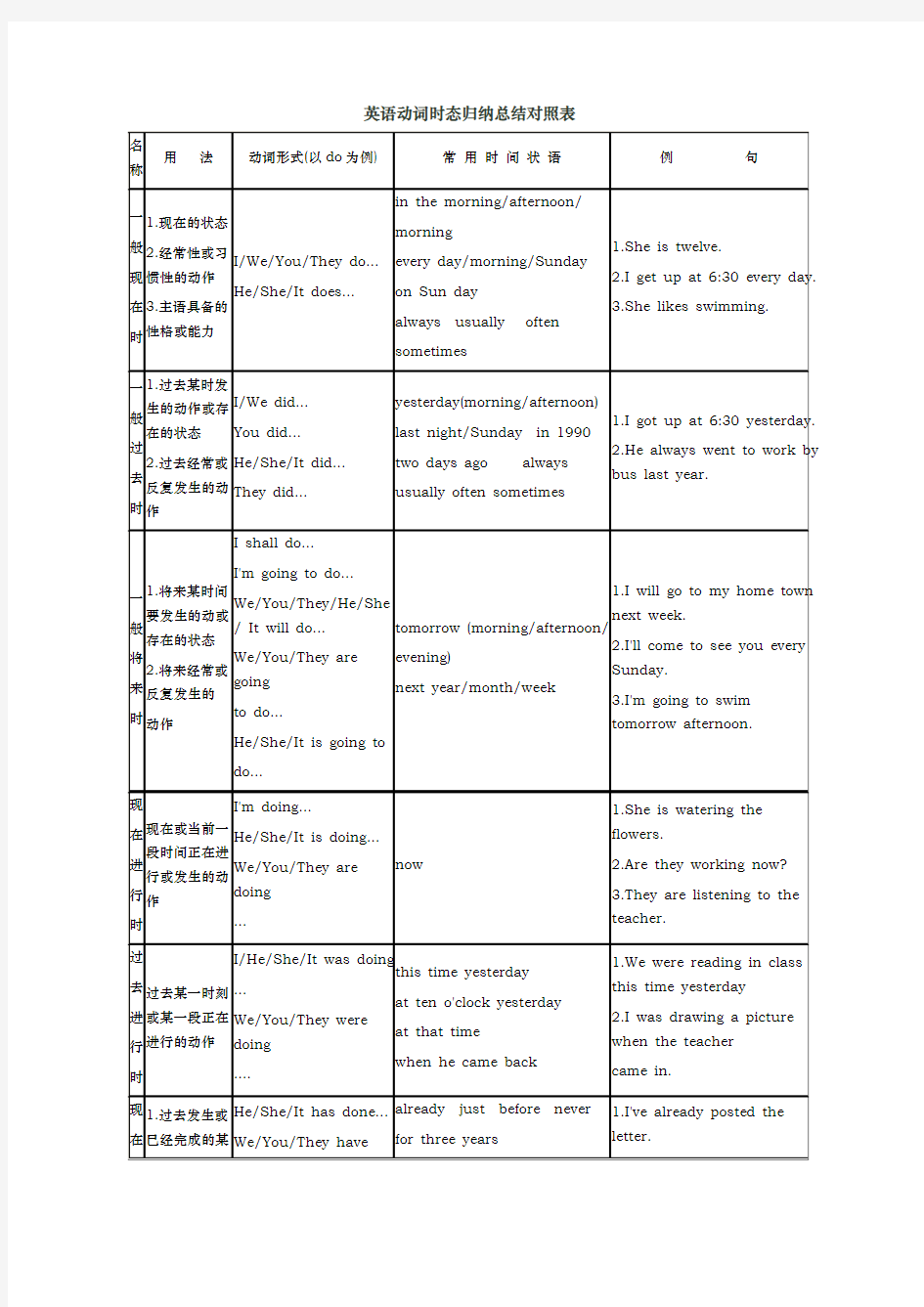

英语动词时态归纳总结对照表
英语时态专项练习
1、一般现在时。
通常用“usually, often, every day, sometimes”。
一般现在时基本用法介绍
一、一般现在时的功能
1.表示事物或人物的特征、状态。如:The sky is blue.天空是蓝色的。
2.表示经常性或习惯性的动作。如:I get up at six every day.我每天六点起床。
3.表示客观现实。如:The earth goes around the sun.地球绕着太阳转。
二、一般现在时的构成:
肯定句:
1).主语+系动词be(is, am, are )+名词(形容词,介词短语)
2) .其他主语+动词原形+其它
第三人称单数+动词-s+其它
如:I am a boy.我是一个男孩。
We study English.我们学习英语。Mary likes Chinese.玛丽喜欢汉语。
三、一般现在时的变化
否定句: 1)主语+ be (is,am,are)+ not +其它。如:He is not a worker.他不是工人。
2)其他主语+do not(don’t)动词原形+其它 I don't like bread
第三人称单数+does not(doesn’t)动词原形+其它He doesn't often play.
一般疑问句:1)Be(Is,Are)+主语+其它?如:-Are you a student? -Yes. I am. / No, I'm not.
2)Do其他主语+动词原形+其它?
Does+第三人称单数+动词原形+其它+?
注意:遇I/we—you, my—your, some—any.
Does she go to work by bike? - Yes, she does. / No, she doesn't.
Do you often play football?- Yes, I do. / No, I don't.
特殊疑问句:疑问词+一般疑问句。如:Where is my bike?
How does your father go to work?
2、现在进行时。
通常用“now/look/listen”.
1.现在进行时表示现在正在进行或发生的动作,也可表示当前一段时间的活动或现阶段正在进行的动作。
2.现在进行时的结构:.
肯定句:主语+be(is,am,are )+动词现在分词-ing
eg: I am(not) doing my homework.
You/We/They are(not) reading.
He/She/It is(not) eating.
否定句:主语+be(is,am,are )+not + 动词现在分词-ing
一般疑问句:Is(Are)+主语+动词现在分词-ing?
特殊疑问:疑问词+ be + 主语+ 动词ing?
3.动词加ing的变化规则
1)一般情况下,直接加ing,如:cook-cooking
2)以不发音的e结尾,去e加ing,如:make-making, taste-tasting
3)如果末尾是一个元音字母和一个辅音字母,双写末尾的辅音字母,再加ing,
如:run-running, stop-stopping,swim—swimming
3、一般过去时态
一般过去时通常用“a moment ago, just now, yesterday, last…”等。
1.一般过去时表示过去某个时间发生的动作或存在的状态,常和表示过去的时间状语连用。一般过去时也表示过去经常或反复发生的动作感。
2.Be动词在一般过去时中的变化:
⑴am 和is在一般过去时中变为was。(was not=wasn’t)
⑵are在一般过去时中变为were。(were not=weren’t)
⑶带有was或were的句子,其否定、疑问的变化和is, am, are一样,即否定句在was或were 后加not,一般疑问句把was或were调到句首。
3.行为动词的一般过去时变化
规则动词的变化:
原形过去式原形过去式原形过去式原形过去式
sweep swept teach taught have had go went
keep kept think thought do did find found
sleep slept buy bought eat ate say said
feel felt drink drank is/am was take took
read read give gave are were mean meant
put put sing sang drive drove meet met
cut cut begin began speak spoke make made
let let ring rang write wrote see saw
fly flew run ran ride rode come came
draw drew sit sat hear heard tell told
grow grew learn learned/ learnt get got know knew
5.特殊疑问句:
⑴疑问词+did+主语+动词原形?如:What did Jim do yesterday?
⑵疑问词当主语时:疑问词+动词过去式?如:Who went to home yesterday?
4、一般将来时
概念:表示将要发生的动作或存在的状态及打算、计划或准备做某事。句中一般有以下时间状语:tomorrow, next day(week, month, year…),soon, the day after tomorrow(后天)等。
1.基本结构:①主语+be (is,am,are)going to +动词原形.
②主语+will+ 动词原形.
2.否定句:①主语+be (is,am,are)+not +going to +动词原形.
②主语+will +not(won’t)+ 动词原形.
例如:I’m going to have a picnic this afternoon.→ I’m not going to have a picnic this afternoon.
3.一般疑问句:①Is(Are)+主语+going to +动词原形.+?
②Will+主语+动词原形+?
例:We are going to go on an outing this weekend.
→ Are you going to go on an outing this weekend? Yes,we are. No, we aren’t.
Will he go to Beijing next week? Yes,he will. No,he won’t.
4.对划线部分提问。一般情况,一般将来时的对划线部分有三种情况。
1). 问人。Who 例如:I’m going to New York soon. →Who’s going to New York soon.
2). 问干什么。What … do.例如:My father is going to watch a race with me this afternoon. →What is your father going to do with you this afternoon.
3). 问什么时候。When.例如:She’s going to go to bed at nine. →When is she going to bed?
5同义句:be going to = will I am going to go swimming tomorrow(明天). = I will go swimming tomorrow.
5.过去进行时:
肯定句:主语+助动词be (was,were)+动词现在分词-ing+其它
否定句:主语+助动词be (was,were)+not+动词现在分词-ing+其它
一般疑问句:Was(Were)+主语+动词现在分词-ing+其它?
特殊疑问句:疑问词+was(were)+动词现在分词-ing+其它?
用法:
1、表示在过去某一时间正在进行的动作,往往有表示过去的时间状语then, at that time, this time yesterday等,或与过去发生的某事同时发生的动作(即与when, while引出的时间状语从句连用)。
例:They were talking about a film at six yesterday evening. 昨晚6点他们正在谈论一部电影。
What were you doing at this time last week? 上周的这个时候你在干什么?
When the teacher came in, they were talking. 老师进来时,他们在讲话。
2、表示在过去某一段时间进行的动作。
例:They were swimming from two to three yesterday afternoon. 昨天下午2点到3点他们在游泳。
She was watching TV the whole morning. 她整个上午在看电视。
3、表示过去将要发生的动作。
例:He said he was leaving on Tuesday. 他说他周二动身。
Tom said he was going tomorrow. 汤姆说他明天去。
4、用过去进行时描写故事背景。
例:It was getting dark. The wind was rising. 天渐渐黑了下来,风势增强了。
The procession was going. He was standing among the crowd looking on. 队伍在前进。他站在人群中观看。
6.现在完成时
构成:肯定句:主语+助动词have(has)+动词过去分词-ed
否定句:主语+助动词have(has)+not(haven’t,hasn’t)+动词过去分词-ed
一般疑问句:Have(Has)+ 主语+动词过去分词-ed+?
特殊疑问句:疑问词+have(has)+ 主语+动词过去分词-ed+?
用法:
1、表示说话之前已完成的动作,而且这个动作的结果对现在是情况仍有影响。常被
just,already,yet 等副词修饰。
Mr. Wang has just come back from America. 王先生刚从美国回来。
2.现在完成时还可用来表示过去发生的动作一直延续到现在,常带有for或since 等表示一段时间的状语。
如:Mr Wang has lived here since 1983.
3.现在完成时瞬间动词即终止性动词不能与表示一段时间的状语连用。
常见终止性动词与延续性动词(或状态动词) 的对应关系如下:
come / go / arrive / get / reach / move--- be in/at
open --- be open die --- be dead
close --- be closed become ---be
borrow --- keep put on --- wear
buy --- have leave ----- be away (from)
begin / start ----- be on fall asleep ---- be asleep
end/finish ----- be over catch a cold ----- have a cold
join the army ---- be in the army, be a soldier
join the Party---- be in the Party , be a Party member
例:吉姆买这支已有两年了。
Jim bought this pen two years ago.
Jim has had this pen for two years.
Jim has had this pen since two years ago.
Jim has had this pen since 2007
It is two years since Jim bought this pen.
4.在表示“最近几世纪/ 年/ 月以来……”时间状语中,谓语动词用现在完成时。
in the past few years/months/weeks/days;over the past few years; during the last three months; for the last few centuries, through centuries; throughout history 等